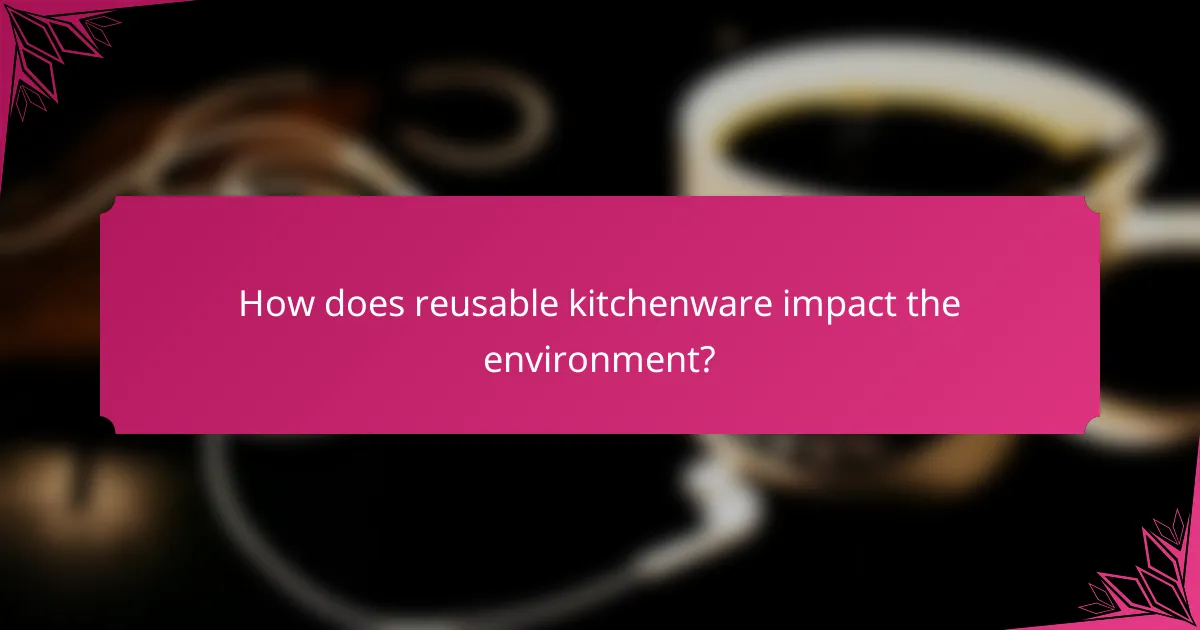Investing in reusable kitchenware not only leads to significant cost savings by reducing the need for disposable items, but also promotes a more sustainable lifestyle. With proper care, many durable alternatives can last for years or even decades, making them a smart choice for both your wallet and the environment. By choosing reusable options, you actively participate in minimizing waste and lowering resource consumption, contributing to a healthier planet.

How can reusable kitchenware save you money?
Reusable kitchenware can significantly reduce your expenses over time by eliminating the need for frequent purchases of disposable items. By investing in durable alternatives, you not only save money but also contribute to a more sustainable environment.
Reduction in disposable product costs
Using reusable kitchenware decreases the amount spent on disposable products like plastic wrap, aluminum foil, and single-use utensils. For instance, a set of reusable silicone food storage bags may cost more upfront but can replace hundreds of disposable bags over their lifespan. This shift can lead to savings in the long run.
Moreover, many households find that they spend a considerable portion of their budget on disposable items. By switching to reusables, you can redirect that money towards more sustainable options, ultimately enhancing your kitchen’s efficiency.
Long-term investment benefits
Investing in high-quality reusable kitchenware often pays off over time, as these products are designed to last for years. Items like stainless steel containers or glass jars can withstand regular use and washing, reducing the need for replacements. This longevity translates into lower costs per use compared to frequently buying disposables.
Additionally, many reusable products come with warranties or guarantees, ensuring that your investment is protected. This added assurance can make the initial purchase feel less daunting and more worthwhile.
Cost comparison with single-use items
When comparing costs, single-use items typically seem cheaper at first glance, but the cumulative expenses add up quickly. For example, a pack of disposable plates may only cost a few dollars, but purchasing them regularly can exceed the cost of a set of durable plates within a year.
To illustrate, consider that a family might spend around $100 annually on disposable cutlery, while a one-time purchase of reusable cutlery could be around $30. Over three years, the savings become evident, showcasing the financial benefits of making the switch.

What is the longevity of reusable kitchenware?
The longevity of reusable kitchenware varies significantly based on the material used, with many options lasting several years or even decades when properly cared for. Understanding the durability of different materials helps consumers make informed choices that benefit both their wallets and the environment.
Durability of stainless steel products
Stainless steel kitchenware is known for its exceptional durability, often lasting 10 to 20 years or more with proper maintenance. It resists rust, stains, and corrosion, making it ideal for various kitchen tasks.
To maximize the lifespan of stainless steel items, avoid using abrasive cleaners and always dry them thoroughly after washing. This prevents water spots and maintains their appearance.
Life expectancy of silicone kitchenware
Silicone kitchenware typically has a life expectancy of around 5 to 10 years, depending on usage and care. High-quality silicone can withstand extreme temperatures and is resistant to cracking, making it a versatile choice for baking and cooking.
To extend the life of silicone products, avoid exposing them to direct flame and refrain from using sharp utensils that can cause cuts or tears.
Comparison of glass vs. plastic longevity
Glass kitchenware generally outlasts plastic, with a lifespan of 10 to 30 years compared to plastic’s 5 to 10 years. Glass is non-porous, does not absorb odors or stains, and can be safely used in microwaves and ovens.
Plastic, while lightweight and convenient, can degrade over time, especially when exposed to heat or harsh chemicals. Opt for BPA-free plastics to minimize health risks and consider replacing them regularly to ensure safety and performance.

How does reusable kitchenware impact the environment?
Reusable kitchenware significantly reduces environmental harm by minimizing waste and lowering resource consumption. By opting for these products, consumers contribute to a healthier planet through decreased reliance on single-use plastics.
Reduction in plastic waste
Using reusable kitchenware directly cuts down on the amount of plastic waste generated. Single-use items, such as plastic utensils and containers, often end up in landfills or oceans, taking hundreds of years to decompose. In contrast, reusable options can last for years, significantly reducing the overall volume of waste.
For example, a household that switches from disposable plates to reusable ones can prevent dozens of plastic plates from being discarded each year. This shift not only conserves resources but also helps to mitigate the pollution associated with plastic production and disposal.
Lower carbon footprint of production
The production of reusable kitchenware generally has a lower carbon footprint compared to single-use items. Manufacturing processes for disposable plastics often involve high energy consumption and emissions. In contrast, reusable products, made from materials like stainless steel or glass, can be produced with more sustainable practices.
Moreover, while the initial production of reusable items may require more resources, their longevity means that over time, the overall environmental impact is reduced. For instance, a single stainless steel water bottle can replace hundreds of plastic bottles, leading to significant energy and resource savings.
Benefits to marine life and ecosystems
Reducing plastic waste through the use of reusable kitchenware benefits marine life and ecosystems significantly. Plastics that enter oceans can cause harm to wildlife, often leading to ingestion or entanglement. By minimizing plastic usage, we help protect these vulnerable species and their habitats.
Additionally, healthier ecosystems contribute to biodiversity, which is crucial for maintaining the balance of our environment. Choosing reusable kitchenware is a simple yet effective way to support marine conservation efforts and promote ecological health.

What are the best types of reusable kitchenware?
The best types of reusable kitchenware include containers, utensils, and tools designed to minimize waste and maximize longevity. These items not only help reduce environmental impact but also offer cost savings over time through their durability and reusability.
Top brands for reusable containers
Some leading brands for reusable containers include Pyrex, Rubbermaid, and OXO. These companies offer a variety of options, from glass to BPA-free plastic, catering to different storage needs and preferences.
When selecting a brand, consider factors such as durability, ease of cleaning, and whether the materials are microwave and dishwasher safe. Investing in high-quality containers can lead to significant savings in the long run.
Best materials for eco-friendly kitchenware
Eco-friendly kitchenware is typically made from materials like stainless steel, glass, bamboo, and silicone. These materials are not only sustainable but also safe for food storage and preparation.
Stainless steel is durable and resistant to staining, while glass is non-toxic and recyclable. Bamboo offers a biodegradable option, and silicone is flexible and reusable, making it ideal for various kitchen applications.
Popular reusable utensils and tools
Common reusable utensils and tools include stainless steel straws, bamboo cutlery sets, and silicone baking mats. These items help reduce single-use plastic waste and can be used repeatedly without degrading in quality.
When choosing reusable utensils, look for products that are easy to clean and maintain. For instance, silicone mats can withstand high temperatures and are dishwasher safe, making them a practical choice for baking enthusiasts.

What criteria should you consider when choosing reusable kitchenware?
When selecting reusable kitchenware, consider factors such as material safety, compatibility with your current kitchen items, and the balance between price and quality. These criteria will help ensure that your choices are both practical and beneficial for your health and the environment.
Material safety and health standards
Material safety is crucial when choosing reusable kitchenware. Look for products made from food-grade materials that are free from harmful chemicals like BPA and phthalates. Certifications such as FDA approval or compliance with European food safety standards can provide assurance of safety.
Additionally, consider the longevity of the materials. Stainless steel, glass, and certain high-quality plastics are generally safe and durable options. Avoid items that may leach chemicals over time, especially when exposed to heat or acidic foods.
Compatibility with existing kitchen items
Ensure that your new reusable kitchenware is compatible with your existing kitchen items. This includes checking sizes, shapes, and functionality. For example, if you have a set of pots and pans, make sure that your new lids or storage containers fit well and can be used interchangeably.
Consider how the new items will integrate into your cooking and storage routines. Items that stack easily or can be nested will save space and make organization simpler. Look for versatile products that can serve multiple purposes, such as a mixing bowl that doubles as a serving dish.
Price vs. quality considerations
When evaluating price versus quality, aim for a balance that fits your budget while ensuring durability. Higher-quality reusable kitchenware may have a higher upfront cost but can save you money in the long run by lasting longer and reducing the need for replacements.
Set a budget and compare options within that range. Consider investing in essential items like high-quality knives or durable storage containers, while opting for more affordable options for less critical items. Always check reviews and ratings to gauge the quality before making a purchase.

How to properly care for reusable kitchenware?
Proper care for reusable kitchenware extends its lifespan and maintains its functionality. Regular cleaning, appropriate storage, and mindful usage are essential practices to ensure your kitchenware remains in good condition.
Cleaning tips for stainless steel
To clean stainless steel kitchenware effectively, use warm water and a mild detergent. Avoid abrasive cleaners that can scratch the surface, and instead opt for soft sponges or cloths to preserve the finish.
For tough stains or discoloration, a paste made from baking soda and water can be applied. Let it sit for a few minutes before scrubbing gently, then rinse thoroughly to remove any residue.
Always dry stainless steel items immediately after washing to prevent water spots. Regular maintenance will keep your kitchenware looking new and functioning well for years.
